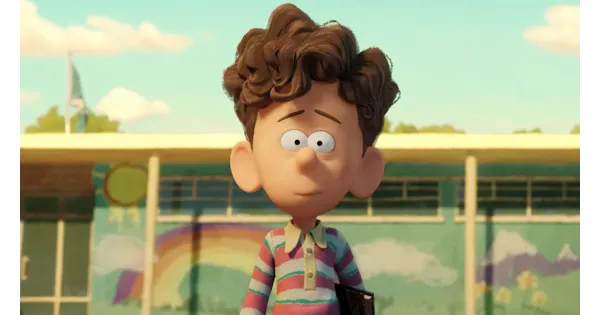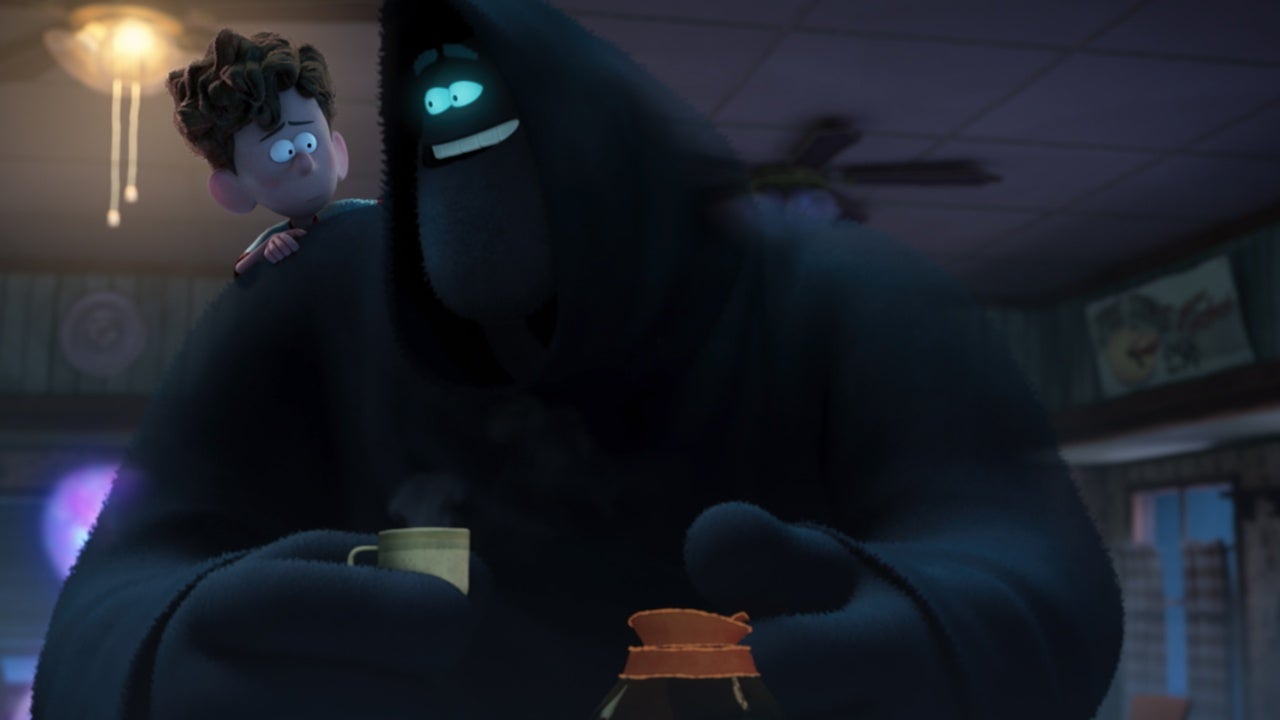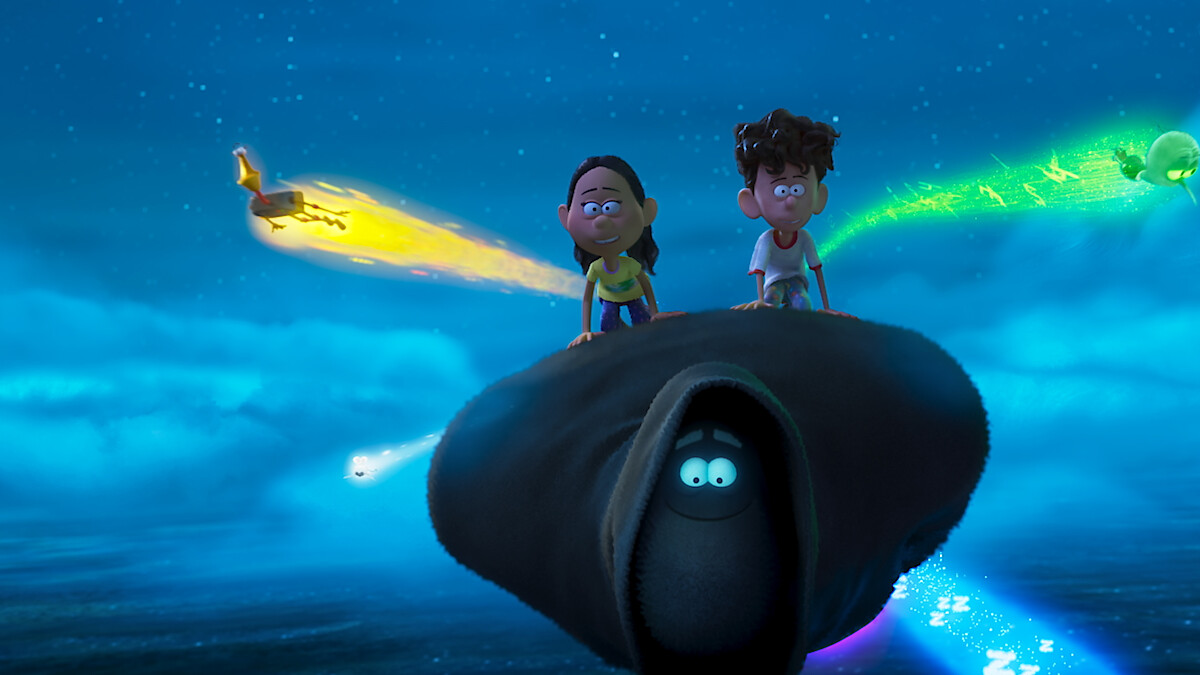The first lines of dialogue in Orion and the Dark come from the title character, and they appear to be directed at the audience: “Hi, my name’s Orion. I’m a kid, just like you. So we have that in common.” It wouldn’t be surprising for any adult viewers to think they might have walked into the wrong theatre – so to speak, as Sean Charmatz‘s film is debuting on Netflix – and that the animated movie they’re watching is indeed pitched entirely at a preteen intellect. It’ll be much to their surprise a few minutes later, then, when Orion starts openly contemplating what it might be like to be dead – that the concept of nothingness isn’t just darkness and silence, but something more unknowable.
Of course, anyone who came in knowing that this is the latest writing effort from Charlie Kaufman – yes, that Charlie Kaufman – won’t be surprised to see a movie that starts out like Diary of a Wimpy Kid turn into something far more existential. And that’s not the last turn the movie takes, not by a long shot. Most of these turns are welcome. Some defy standard narrative structure in ways that feel self-defeating. Others adhere too strictly to formulas we’ve seen before. So yes, it’s possible to be glad for what Kaufman brings to a project like this and disappointed he didn’t bring more, while also wondering if he brought too much. It’s the kind of pretzel logic Kaufman would appreciate.
There’s no doubt that Orion and the Dark, adapted from the children’s story by Emma Yarlett, has ambitions to spare, in terms of both its animation and its storytelling. The artwork is a bit reminiscent of claymation, with the character design in the same neighbourhood as Wallace and Gromit, though it doesn’t limit itself to that, as Orion’s notebook drawings are used to good effect as well. As for the structure of the narrative, Kaufman is working in the realm Wes Anderson has lived in recently, using a bit of a Russian nesting doll structure in different time periods, whose layers should not all be revealed.
Orion (voice of Jacob Tremblay) is your standard neurotic 10-year-old kid – a miniature Kaufman, you might say – who fears everything from bees to the bully at school to talking to a girl he likes. He reserves his most overdeveloped fears for bedtime, when he makes his parents leave his bedroom door open enough to test the hinges in the opposite direction. The dark leaves him in this place of unproductive imagination like thoughts of the nothingness of eternity, and he thinks he sees shapes moving in the blackness. Then one night, he’s sure of it.
The Dark (voice of Paul Walter Hauser, doing his best Seth Rogen impersonation) appears to him in a black hooded robe with a face that might be made of coal. His eyes are kind, and so are his mannerisms. Within a few minutes of their meeting – in which Orion tries to ward him off with a torch – it becomes clear that Dark has been living with the bias that most children and some adults are afraid of him, and it’s taken a clear toll on his sense of self-worth.
Eager to try to quell Orion’s fears, though it’s unclear how lifting off into the stratosphere would do that, Dark carries Orion off on a trip around the world, to show the boy how he brings night to the world and that it’s not scary. Accompanying him on this trip are other night entities, who contribute to the world’s experience of night in their own ways: Insomnia (Nat Faxon), Quiet (Aparna Nancherla), Unexplained Noises (Golda Rosheuvel), Sleep (Natasia Demetriou) and finally Sweet Dreams (Angela Bassett). The entities have a rivalry of sorts with Light (Ike Barinholtz), who sweeps in after them and brings sunlight to the world, and has billions of devotees across the planet. No one is afraid of Light, and Dark starts wondering if he might really be a bad guy after all.
Although there’s quite a lot of imagination going on here – productive imagination in this case – it should also be clear how Orion and the Dark is indebted to successful animated properties that have come before. It’ll be impossible not to think of the emotions in Inside Out (who are returning for a sequel this winter) when considering the night entities, as there’s even almost a direct mapping of their personalities. (Watch Nat Faxon’s Insomnia buzzing around and I dare you not to think of Bill Hader’s Fear, who I suppose would fit right in with the themes of this movie.) These characters are not in Yarlett’s original book, so Kaufman is the one who created them and wrote the dialogue they chirp, all contributing a thought that plays off their personalities in each scene. This may be a necessary concession to the genre he’s working in, but these characters still don’t feel particularly fresh, even while they do have their moments and lay claim to our sympathies.
As the film goes, Kaufman breaks normal conventions to expand the story out in ways beyond what was synopsised above. It’s a playful approach to narrative, but it also diminishes some of the stakes of the most immediate story we’re following, which involves Dark and his campaign to dispel the fears of a child like Orion. It even creates a moment in the third act where the story seems to be wrapped up and then there’s a superfluous branch that needs its own resolution. You can tell when a particular story choice doesn’t quite hit because it’s that moment when you would look at your watch, if you still had one.
So if parts of Orion and the Dark are too dark for young children, and parts have too many sidekicks for most adults, it explains why a movie that has so much going for it isn’t an unqualified success. “Qualified success” describes the vast majority of good movies, most of which don’t feature the talents of the guy who wrote Being John Malkovich and Eternal Sunshine of the Spotless Mind. Certain types of adult will want to see it for that reason alone, and they won’t be sorry they did.
Orion and the Dark is currently streaming on Netflix.



